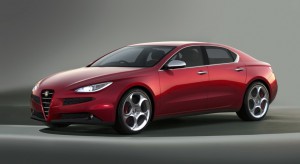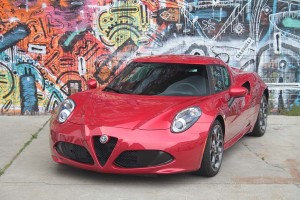
Alfa Romeo plans to introduce a new sedan in the U.S. as part of its plans to sell more than 100,000 vehicles.
Since returning to the U.S. market last year with its little 4C sports car, Alfa Romeo has barely been more than an asterisk on the sales charts, demand so far measured in the hundreds. So, with a goal of getting that up to more than 100,000 vehicles a year, the Italian maker will reach a critical point later this month when it formally unveils an all-new midsize sedan.
Meant to replace the aging Giulia, the new four-door is targeting the world’s largest luxury car segment and will provide the real test of whether Alfa can meet the lofty expectations set by the long-struggling brand’s parent, Fiat Chrysler Automobiles.
The goal is to reach 150,000 sales in North America alone by 2018, with the new sedan the next in a wave of eight products – most targeting a more mainstream luxury audience than the little 4C. FCA has already spent about $2 billion on the revitalization of Alfa Romeo, noted Reid Bigland, the brand’s North American president and CEO, and it is committed to invest $4 billion more.
“We will crank things up” with the midsize sedan, promised Bigland, during an interview in Monterey, California, where he was presiding over a media drive of the Alfa Romeo 4C Spider. “It will give us a lot more mainstream attention.”
Bigland held tight to specific details about the sedan, but insiders reveal that it will be based on an all-new architecture, rather than a warmed-up version of one of Alfa’s existing models. That’s no surprise. Old products, such as the Giulia, have little following outside Europe where sales last year totaled an anemic 68,000.
The new platform has been dubbed the Giorgio, Bigland confirmed, and, unlike the carbon fiber 4C, sticks largely with conventional steel. It is expected to feature a multi-link suspension, offer a choice of both rear- and all-wheel-drive, and use a north-south engine layout.
(To see TDB’s first drive in the Alfa Romeo 4C Spyder, Click Here.)
As for the powertrain, Alfa is expected to have access to a range of new engines, both gas and diesel, from 2.0 liters up to a 3.0-liter V-6. There has been some talk that a small inline-four for the sedan might also become an option for the Alfa 4C which currently offers only a turbo 1.75-liter package.
Pricing for the sedan is expected to start somewhere above $40,000 when the four-door reaches the U.S. early next year as a 2017 model.
The midsize sedan will quickly be followed by a midsize sport-utility vehicle, according to Bigland. That’s no surprise considering utes are rapidly overtaking sedans in the global luxury sales charts. A full-size sedan, the executive added, should follow the SUV.
And then? During a media briefing in May 2014, FCA CEO Sergio Marchionne gave a glimpse of the likely product strategy for Alfa Romeo, but things have shifted a bit since then. For one thing, a small roadster developed as part of a joint project with Mazda will now be badged a Fiat, rather than an Alfa. And the precise cadence of the other new models is still in flux, Bigland confirmed.
(Click Here for details about Ford’s return to Le Mans with the GT.)
But another, smaller ute and a compact sedan are certainties, according to insiders. And in keeping with luxury industry trends, few would be surprised to see Alfa offer some high-performance Quadrifoglio variants – its equivalent of the BMW M and Mercedes AMG lines.
“We have to be a cut above” the broader luxury competition, stressed Bigland, which means a heavy emphasis on performance. Alfa will emphasize emotional, rather than practical, factors, something readily apparent to anyone who has spent time in a 4C.
“It’s about image, it’s about performance,” he added. “It’s more ego-driven than the typical luxury car.”
Part of the challenge for Alfa is making sure that the future products it develops truly fit the brand. To ensure there’s no accidental badge-engineering with FCA’s mainstream brands, Marchionne approved a team of 800 engineers dedicated solely to Alfa Romeo.
“We wanted to avoid contaminating the brand,” said Bigland.
One of the other questions that remains unanswered is whether Alfa will eventually go back into motor sports. In a way, it has, Ferrari’s F1 entries now featuring the Alfa logo, as well. But a true Alfa race car also seems likely, Bigland suggesting, “Racing is obviously in our blood.”
(To see more about the axing of the MKS paving the way for the Continental, Click Here.)
A strong showing on the track would certainly help build the brand’s image. On the downside, said the Alfa chief, “there’s pretty little awareness of Alfa” outside Europe. Then again, that lack of awareness, Bigland suggested, can also be a positive, allowing the maker to create an entirely new image and mythos for itself, rather than trying to reshape its past reputation.


Sorry, but Alfa hasn’t built a Giulia since 1978… I believe you’re referring to the Giulietta…
It’s going to be a tough sell with minimal dealers, lack of parts and properly trained techs, etc. Alfa/Fiat and others have been down this road many times before. The U.S. is a large potential market but without the resources to support the brand it’s doomed in the U.S. At least a few collectors will be happy.